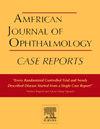在瞳孔成形术中使用角膜-晶状体提取(KLEx)晶状体来保护晶状体:一种用于有晶状体眼的新技术
Q3 Medicine
引用次数: 0
摘要
目的瞳孔成形术是一项精细的技术,特别是在有晶状体的患者中,在手术过程中针头接触晶状体的风险很高。我们报告一例白内障患者,我们使用异体角膜晶状体摘除(KLEx)晶状体在手术过程中暂时保护晶状体。这是一个43岁的男性患者,创伤后颞虹膜缺损。病人主诉有单眼复视和畏光等永久性不适。手术在局部麻醉下进行。第一步在晶体前放置直径6.5 mm、厚度109 μm的KLEx透镜。然后使用Siepser技术定位prolene结,以更安全的方式修复虹膜缺损。手术结束时,从前房取出晶状体。术后随访证实无晶状体损伤,术后6个月无白内障。结论和重要性我们在此报告了一种使用临时KLEx透镜作为虹膜修复部分的瞳孔成形术的新技术。我们发现当针在晶状体前穿过时手术风险要小得多。本文章由计算机程序翻译,如有差异,请以英文原文为准。
Use of a Kerato-lenticule extraction (KLEx) lenticule to protect the lens during pupilloplasty: a novel technique in phakic eyes
Purpose
Pupilloplasty techniques are delicate, especially in phakic patients where the risk of touching the lens with the needle during the procedure is high. We report the case of a phakic patient in whom we used an allogeneic Kerato-lenticule Extraction (KLEx) lenticule temporarily to protect the lens during the procedure.
Observation
This is a 43-year-old male patient with a significant post-traumatic temporal iris defect. The patient complained of permanent discomfort in the form of monocular diplopia and photophobia. Surgery was performed under local anesthesia. The first step was to position a 6.5 mm-diameter, 109 μm-thick KLEx lenticule in front of the crystalline lens. The iris defect was then repaired with greater safety by positioning prolene knots using the Siepser technique. At the end of the procedure, the lenticule was removed from the anterior chamber. Post-operative follow-up confirmed the absence of lens damage, with no cataract at 6 months post-op.
Conclusions and importance
We report here a new technique in pupilloplasty by using a temporary KLEx lenticule as part of the iris repair. We found the procedure much less risky when the needles were passed anterior to the crystalline lens.
求助全文
通过发布文献求助,成功后即可免费获取论文全文。
去求助
来源期刊

American Journal of Ophthalmology Case Reports
Medicine-Ophthalmology
CiteScore
2.40
自引率
0.00%
发文量
513
审稿时长
16 weeks
期刊介绍:
The American Journal of Ophthalmology Case Reports is a peer-reviewed, scientific publication that welcomes the submission of original, previously unpublished case report manuscripts directed to ophthalmologists and visual science specialists. The cases shall be challenging and stimulating but shall also be presented in an educational format to engage the readers as if they are working alongside with the caring clinician scientists to manage the patients. Submissions shall be clear, concise, and well-documented reports. Brief reports and case series submissions on specific themes are also very welcome.
 求助内容:
求助内容: 应助结果提醒方式:
应助结果提醒方式:


